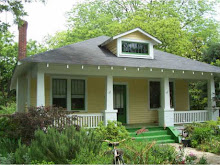
DISCLAIMER: I am not an electrician. I am rewiring our lights as a hobby. Please take on electrical projects at your own risk! Do your research. One thing to consider is that old fixtures are often not originally equipped with a ground wire. For safety purposes, a ground wire was added to our lights when they were installed (not pictured). If there is ever an electrical short in a metal fixture, it could become electrified and shock/harm a person who touches it (the person being the shortest path to the ground). Many everyday objects like table lamps, alarm clocks, toasters, etc don't have a ground (think two-prong vs 3-pronged plug). Hardwired fixtures should always be grounded.

So.... you may remember that a while ago I posted about the cleaning and paint removal from the original antique light fixtures in our house. First I removed all the old 1920s cloth wiring and stripped the paint off the brass. Antique looking parts are not hardware store material, so I had to order everything online. I bought almost all the replacement lamp parts from Grand Brass . I also got some brass darkening solution from Architecturals to patina the new brass fitter. A side note about buying lamp stuff online: I was thrilled to find a mogul socket reducer *geek* which makes it possible to use a standard light bulb in an antique lamp with a oversized mogul socket. I own two mogul floor lamps and the oversized bulbs are hard to find and are usually a bright 100 watts.
Originally I was thinking I might be able to reuse the original ceramic interior sockets (called fatboys because they are bigger than modern sockets). Some of them were quite corroded, so I decided to replace the interiors with modern parts and reuse the original exteriors for looks. I was able to find interior sockets with antique looking turn-key knobs, so they look pretty original! (I'm not throwing away the old ceramic sockets because I hate to discard anything original. They will just serve as art).
Side note: Modern hardwired fixtures often don't have a knob on the socket because they are controlled by a wall switch. It doesn't make a whole lot of sense to have knobs on my pendants but it's how it was done in the 1920s. Knobs on the pan chandeliers are actually useful because you can turn a few bulbs off for a makeshift dimmer.
Here is the basic order:
Old fixture, new wire, old fitter (aka shade holder), old exterior socket top, new cardboard insulator disc, new interior socket, new cardboard insulator, old exterior socket.

Here is a close up of the rayon wire. Inside the black and white rayon is a modern plastic coated wire. Most people would not go through the trouble of using cloth covered wire since these hang from the ceiling (rayon wire is usually used for table lamps), but we wanted to keep the look authentic.

Plain plastic lamp wire is easier to work with than this rayon covered plastic wire. I wasn't sure how the pros keep keep the rayon from unraveling, so I improvised by covering the ends of each wire with electrical tape. This will get brittle over time, but it's not serving an electrical function, it's just keeping the rayon from moving around.
At this point, the wire has been threaded through the end of the fixture chain, the fitter, the top of the exterior socket and the paper disc and I'm ready to attach it to the interior socket. This picture shows an "underwriter's knot". This knot prevents the wires from slipping off the screws if someone accidently yanks on the cord (standard wiring process).

Screw the wires onto the socket. Standard process is that black is hot so it goes on the gold screw. White is neutral and goes on the silver.

Once the socket is wired, you slide the cardboard insulator over it, ensuring to cover the screws so they don't short out on the exterior socket.

Then you slide the exterior socket over that, and it's ready to pop together with the top of the exterior socket.

Now it's time to screw the socket to the fixture chain end. I have not laced the other end of the wire up through the chain yet. This is because you want the wire to be free to twist with the socket at this time. The fitter gets turned too because the knob is sticking out the side.

Lace the wire up the chain after it's all screwed together and it's finished! I tested each lamp by jerry-rigging a plug by splicing the wires to a plug from a strand of Christmas lights. Yay, it works!

One finished pendant.

The finished bathroom sconce.

Next up... the Pan Chandeliers

The pan chandelier is basically four pendant lamps that are wired together. I wired each socket, then laced the wires up into the pan.
There is an additional length of wire that is laced down one of the chains from the ceiling. You attach all four lamp wires to this one wire.

Separate all the black wires from the white wires. (Note: It is recommended to use a heavier gauge wire if doing this sort of thing to a chandelier with lots of lights)

Twist the black wires all together and join them with a wire connector. This connection ensures that each bulb is connected to the main power, so all bulbs will work even if one burns out.

Lay the wires down in the pan so they are not visible when the chandelier is hanging.

TADA!
Along with a few other replacement parts the whole thing cost less than $100 to clean and rewire all the lamps. They are safe, they function, and they look a helluva lot better. We'll post pictures of them installed once the house is cleaned up and we put the pretty glass shades on!




